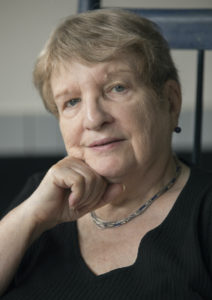Life Moves: The long (rewarding) haul of writing ballet lives - Vancouver Ballet Society
- Home
- Life Moves
- Life Moves: The long (rewarding) haul of writing ballet lives

By Martha Ullman West
My goal was to write a short biography of Janet Reed, to be titled Pioneer on Pointe, a project I planned to complete in a year. I ended up writing a 400-page book about her and Todd Bolender, Reed’s partner in many endeavours, and their considerable contributions to the establishment of ballet as an expression of American culture.
I first saw Reed and Bolender dance in the late 1940s, when I was ten and New York City Ballet was taking its first baby steps, watching them from the cheap seats in the second balcony of New York City Center. My mother, who had seen Pavlova dance in Detroit, took me to the mixed repertoire show, in which Reed’s sparkling, joyous dancing in Balanchine’s Symphony in C was like being allowed a taste of champagne. But I confess it was Maria Tallchief’s powerhouse performance in The Firebird in a different show that made the young me, who had already declared her intention of becoming a poet, ask for ballet lessons. My career at the School of American Ballet was brief: my feet were pronounced good; the rest of my body wasn’t strong enough for the training.

I didn’t really notice Bolender (or any other male dancer) until 1957, when I saw him dance the Sarabande in Balanchine’s Agon during its first season, sitting again in the second balcony, where, as a Barnard College student, I could afford the ticket price. Another student, Tobi Tobias, who was a year ahead of me, published my poetry in the college literary magazine, and then, 20 years later, conscripted me into the dance writing profession when she was an editor at Dance Magazine. That’s when the two means of artistic expression came together in my life: as a dance writer, I made use of the tools of the poet to describe dance and dancers in quite a few local, national and international publications, including Dance International.
In 1988, I attended a Dance Critics Association conference on Swan Lake in San Francisco, where Reed was interviewed about her experience dancing Odile in the first evening-length production choreographed by an American. By then, I knew that Reed — a descendant of Oregon pioneers — had been the first Juliet in American versions of Romeo and Juliet, and the first Swanhilda in Coppélia, all three choreographed by Willam Christensen for the San Francisco Ballet.
My book proposal took a while — I was a busy freelancer, faculty wife and mother — but in the late 1990s I circulated one that two presses rejected, after which I decided to write the book first and then see if I could find a publisher. I began interviewing people who had known Reed, who had died in 2000 before I could sit down with her. In 2001, I went to Kansas City to talk with Bolender. At 88, Bolender, who was Kansas City Ballet’s artistic director emeritus, was still actively involved in the company he had made professional two decades earlier, rehearsing the dancers in his ballets and participating in fundraising events.
Bolender adored Reed, and loved talking about their history as dancing partners, teaching colleagues and close friends. This is when I realized the book needed to be about him, too.
When I told him that, he said, “Better hurry up, sweetheart.” So, like Margaret Mead rushing to interview elderly Samoans before they died and their culture died with them, I spent the next five years grilling Bolender in various locations: Seattle, where he staged his Souvenirs on Pacific Northwest Ballet in 2002; in Kansas City several times, where I also interviewed many dancers, friends, Kansas City Ballet staff members and funders; on vacation in the Florida panhandle; and, in 2004, in New York for a Guggenheim Works and Process event in connection with Balanchine’s centennial.

Bolender died in 2006, but I kept travelling for interviews with his colleagues — Yvonne Patterson, whom he’d known since both danced with the Littlefield Ballet in 1940, outside Philadelphia shortly after her 100th birthday; his Turkish translator and close friend Sevgi Sanli outside London, about the two decades in which Bolender directed American musicals and ballet companies in Istanbul and Ankara; and dancers he’d worked with in opera house ballet companies in Cologne and Frankfurt.
Reed’s two children gave me access to her correspondence and unpublished memoirs, and in many conversations and e-mails helped me to know what made her tick. Her son used the phrase “dogged determination” to describe the years when she supported her family economically by performing beyond the time many dancers retire. She also continued teaching, returning to the west coast to lay the foundation for Pacific Northwest Ballet by establishing the PNB School.
By 2008, when I successfully submitted my proposal and sample chapters to University Press of Florida, I had become a compulsive researcher. Between then and the publication in 2021 of Todd Bolender, Janet Reed, and the Making of American Ballet, I travelled to San Francisco to rummage through the San Francisco Ballet archives, back to Kansas City to prowl through Bolender’s papers again, and to New York to the Jerome Robbins Division of the New York Public Library for the Performing Arts in order to learn more about Balanchine, Kirstein, Jerome Robbins, Eugene Loring, Turkish dance, German ballet, Catherine Littlefield, Agnes de Mille — all, or most, of the branches and twigs on the family tree of dance influences on these two hard-working, fun-loving, driven, gifted, talented people. I’m glad the book is out in the world, but I do miss their presence in my mind and memory as an integral part of what amounts to a quarter of my life.

